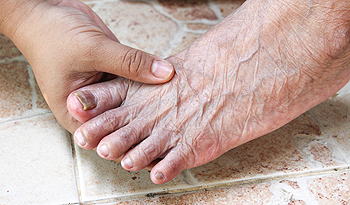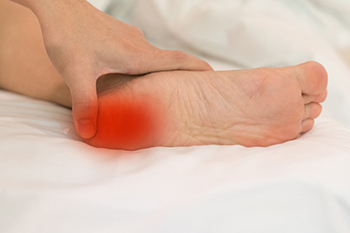November 2024
Reminder: When Was the Last Time...?
Causes of Pain in the Ball of the Foot

Pain in the ball of the foot, known as metatarsalgia, can result from various causes. Among them are stress fractures in the metatarsal bones, joint pain, and inflammation of the two sesamoid bones located under the big toe. Morton’s neuroma, a nerve-related issue, may also contribute to pain in the ball of the foot. It arises when nerves between the 3rd and 4th toes are compressed, often causing tingling and pain. Age-related thinning of the fat pad in this area can lead to less cushioning, increasing the likelihood of pain with walking or standing. Posture issues and biomechanical imbalances, which may result from poor gait mechanics, can put excessive pressure on the ball of the foot. Increased stress on the metatarsal area can encourage the development of secondary issues. A podiatrist can provide an accurate diagnosis and treatment plan to alleviate pain, prevent further complications, and help restore comfort. If you are experiencing pain in the ball of the foot, it is suggested that you make an appointment with a podiatrist for an exam and treatment.
Foot Pain
Foot pain can be extremely painful and debilitating. If you have a foot pain, consult with Dr. Thomas Madden from Advanced Foot Care Center. Our doctor will assess your condition and provide you with quality foot and ankle treatment.
Causes
Foot pain is a very broad condition that could be caused by one or more ailments. The most common include:
- Bunions
- Hammertoes
- Plantar Fasciitis
- Bone Spurs
- Corns
- Tarsal Tunnel Syndrome
- Ingrown Toenails
- Arthritis (such as Gout, Rheumatoid, and Osteoarthritis)
- Flat Feet
- Injury (from stress fractures, broken toe, foot, ankle, Achilles tendon ruptures, and sprains)
- And more
Diagnosis
To figure out the cause of foot pain, podiatrists utilize several different methods. This can range from simple visual inspections and sensation tests to X-rays and MRI scans. Prior medical history, family medical history, and any recent physical traumatic events will all be taken into consideration for a proper diagnosis.
Treatment
Treatment depends upon the cause of the foot pain. Whether it is resting, staying off the foot, or having surgery; podiatrists have a number of treatment options available for foot pain.
If you have any questions, please feel free to contact our office located in Killeen, TX . We offer the newest diagnostic and treatment technologies for all your foot care needs.
Causes of Big Toe Joint Pain

Pain in the big toe can affect your daily activities and foot function. Injuries like turf toe, a sprain often seen in athletes and dancers, can lead to joint pain and swelling when the big toe is forcefully bent upwards. Certain chronic conditions also play a role in causing big toe pain. Arthritis, particularly osteoarthritis, can cause joint stiffness and discomfort due to cartilage breakdown, often worsened by repetitive movements or previous injuries. Gout, a metabolic condition where uric acid crystals accumulate in the joint, and causes intense pain and inflammation in the big toe, especially during flare-ups. Bunions, a structural deformity, push the big toe toward the other toes, causing visible bumps and pain, especially when wearing tight shoes. Sesamoiditis, involving small bones under the big toe joint, commonly affects people who engage in activities that put pressure on the forefoot. A podiatrist can diagnose these issues and recommend specific treatment, including orthotics to reduce strain and even surgery in severe cases. If big toe pain is interfering with your daily activities, it is suggested that you schedule an appointment with a podiatrist for an exam and treatment.
Toe pain can disrupt your daily activities. If you have any concerns, contact Dr. Thomas Madden of Advanced Foot Care Center. Our doctor can provide the care you need to keep you pain-free and on your feet.
What Causes Toe Pain?
Most severe toe pain is caused due to a sports injury, trauma from dropping something heavy on the toe, or bumping into something rigid. Other problems can develop over time for various reasons.
Toe pain can be caused by one or more ailments. The most common include:
- Trauma
- Sports injury
- Wearing shoes that are too tight
- Arthritis
- Gout
- Corns and calluses
- Hammertoe
- Bunions
- Blisters
- Ingrown toenails
- Sprains
- Fractures (broken bones)
- Dislocations
When to See a Podiatrist
- Severe pain
- Persistent pain that lasts more than a week
- Signs of infection
- Continued swelling
- Pain that prevents walking
Diagnosis
In many cases the cause of toe pain is obvious, but in others, a podiatrist may want to use more advanced methods to determine the problem. These can range from simple visual inspections and sensation tests to X-rays and MRI scans. Prior medical history, family medical history, and any recent physical traumatic events will all be taken into consideration for a proper diagnosis.
Treatment
Treatments for toe pain and injuries vary and may include shoe inserts, padding, taping, medicines, injections, and in some cases, surgery. If you believe that you have broken a toe, please see a podiatrist as soon as possible.
If you have any questions please feel free to contact our office located in Killeen, TX . We offer the newest diagnostic tools and technology to treat your foot and ankle needs.
Fungal Toenail Treatment Options

Fungal nails, or onychomycosis, is a common condition where a fungus infects the toenails, leading to discoloration, thickening, and brittleness. The primary causes include exposure to warm, moist environments, such as public showers or swimming pools, and underlying conditions like diabetes or weakened immune systems. Symptoms often start with a yellow or white spot under the nail, progressing to discoloration and potential separation from the nail bed. In some cases, the affected nail may become painful or develop a foul odor. A podiatrist can effectively diagnose and treat fungal toenails through various methods. Treatments may include topical antifungal medications, oral medications, and advanced options like laser therapy, which targets the infection without harming surrounding tissue. Laser treatments are gaining popularity for their effectiveness and minimal side effects. If you have toenail fungus, it is suggested that you schedule an appointment with a podiatrist for personalized care and treatment options.
For more information about treatment, contact Dr. Thomas Madden of Advanced Foot Care Center. Our doctor can provide the care you need to keep you pain-free and on your feet.
Toenail Fungus Treatment
Toenail fungus is a condition that affects many people and can be especially hard to get rid of. Fortunately, there are several methods to go about treating and avoiding it.
Antifungals & Deterrence
Oral antifungal medicine has been shown to be effective in many cases. It is important to consult with a podiatrist to determine the proper regiment for you, or potentially explore other options.
Applying foot powder on the feet and shoes helps keep the feet free of moisture and sweat.
Sandals or open toed shoes – Wearing these will allow air movement and help keep feet dry. They also expose your feet to light, which fungus cannot tolerate. Socks with moisture wicking material also help as well.
If you have any questions please feel free to contact our office located in Killeen, TX . We offer the newest diagnostic tools and technology to treat your foot and ankle needs.
Sever’s Disease in Kids

Sever's disease, or calcaneal apophysitis, is a common cause of heel pain in growing children, typically between ages eight and 14. It occurs when the growth plate in the heel bone becomes inflamed due to repetitive stress, often from sports or activities that involve running and jumping. Symptoms include heel pain, tenderness, and swelling, particularly after physical activity. The discomfort may worsen when walking or standing on tiptoes. Diagnosis is based on a clinical examination, medical history, and occasionally imaging scans to rule out other causes. Treatment focuses on reducing pain and inflammation through rest and targeted stretching exercises. In some cases, custom orthotics or heel cups may be prescribed by a podiatrist to provide cushioning. Most children recover fully with proper management, and the condition resolves once the heel bone finishes growing. If your child complains of persistent heel pain, is limping, or avoiding walking, it is suggested that you visit a podiatrist for a proper diagnosis and relief options.
Sever's disease often occurs in children and teens. If your child is experiencing foot or ankle pain, see Dr. Thomas Madden from Advanced Foot Care Center. Our doctor can treat your child’s foot and ankle needs.
Sever’s Disease
Sever’s disease is also known as calcaneal apophysitis, which is a medical condition that causes heel pain I none or both feet. The disease is known to affect children between the ages of 8 and 14.
Sever’s disease occurs when part of the child’s heel known as the growth plate (calcaneal epiphysis) is attached to the Achilles tendon. This area can suffer injury when the muscles and tendons of the growing foot do not keep pace with bone growth. Therefore, the constant pain which one experiences at the back of the heel will make the child unable to put any weight on the heel. The child is then forced to walk on their toes.
Symptoms
Acute pain – Pain associated with Sever’s disease is usually felt in the heel when the child engages in physical activity such as walking, jumping and or running.
Highly active – Children who are very active are among the most susceptible in experiencing Sever’s disease, because of the stress and tension placed on their feet.
If you have any questions, please feel free to contact our office located in Killeen, TX . We offer the newest diagnostic and treatment technologies for all your foot and ankle injuries.





